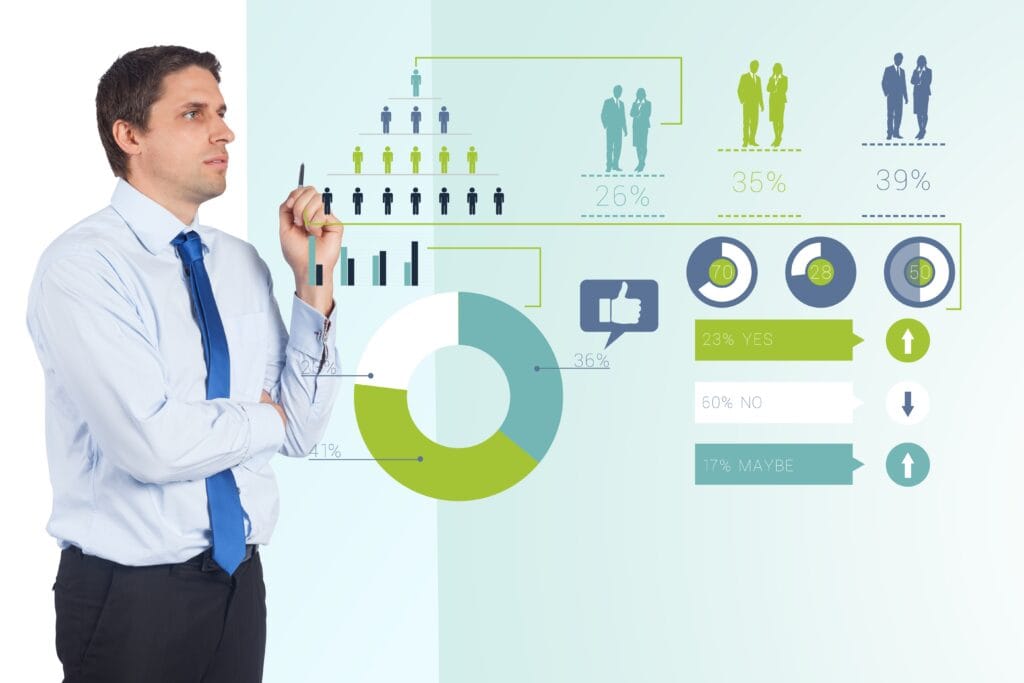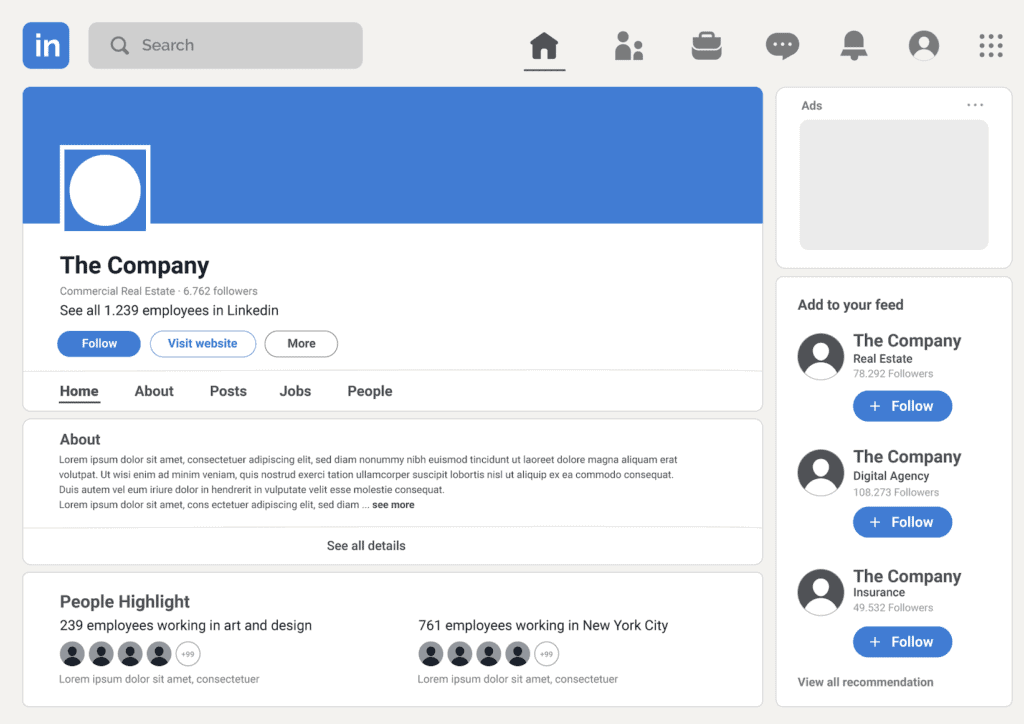In today’s rapidly evolving digital landscape, the art of lead generation has become pivotal for businesses seeking sustainable growth. However, simply generating leads is not enough; measuring the effectiveness of these efforts is crucial.
This necessitates a deep dive into lead generation metrics and Key Performance Indicators (KPIs), which serve as the compass guiding businesses toward better strategies and enhanced outcomes.
Understanding lead generation metrics is not just about counting potential customers; it’s about analyzing the quality, behavior, and conversion rates of these leads to refine marketing approaches and boost sales efficiency.
Whether you’re operating in a B2B or B2C environment, the ability to measure and interpret these metrics can dramatically impact your business’s ability to generate revenue and secure a competitive edge in your market.
This article aims to get into the complex world of lead generation metrics, offering a structured exploration from foundational definitions to advanced analytical techniques.
By integrating these metrics into your business strategy, you are equipped to make informed decisions that not only attract more leads but also enhance the quality and profitability of each customer interaction.
Introduction to Measuring Lead Generation

Measuring lead generation is fundamental for any business striving to optimize marketing strategies and ensure a high return on investment (RoI).
By examining various metrics at each stage of the lead funnel, businesses can identify areas of wastage, allocate resources more effectively, and refine their tactics to maximize efficiency and profitability.
Here’s a focused discussion on why measuring these metrics is crucial, especially in the context of cost optimization and driving RoI.
The table below details each stage of the lead generation funnel, highlighting the specific metrics tracked at each point, and explaining their significance in measuring overall campaign effectiveness:
| Funnel Stage | Metric | Purpose of Measurement |
|---|---|---|
| Campaign Launch | Cost Per Campaign | Measures the total expenditure on a campaign to assess initial investment and budget adherence. |
| Visitor Engagement | Clicks | Tracks user interaction with the campaign to gauge initial interest and engagement level. |
| Interest Generation | Click-Through Rate (CTR) | Evaluates the effectiveness of campaign messaging and its ability to encourage further action. |
| Lead Conversion | Leads Generated | Counts the number of potential customers interested enough to provide contact details, indicating potential for sales. |
| Lead Engagement | Lead Connect Rate | Measures how many of these leads are successfully contacted, assessing the quality of leads and initial engagement efficiency. |
| Sales Conversion | Conversion Rate | Tracks the percentage of leads that turn into customers, providing a direct measure of campaign success and ROI. |
Each of these metrics provides crucial insights at various stages of the lead generation process. By analyzing these data points, businesses can:
- Identify Cost Inefficiencies: Understand where money is being spent without corresponding results, allowing for reallocation or strategy adjustments.
- Enhance Engagement Tactics: Modify approaches based on which stages show lower engagement or higher drop-off rates.
- Improve Lead Quality: Adjust lead acquisition strategies to focus more on lead quality rather than quantity, ensuring better conversion rates.
- Maximize ROI: By continually refining strategies based on these metrics, companies can increase the efficiency of each campaign, leading to higher returns on every dollar spent.
This approach not only helps in tightening the marketing budget but also in amplifying the effectiveness of each campaign, thereby driving better returns and achieving sustainable business growth.
Defining Key Terms: Metrics and KPIs in Lead Generation
From the above discussion, lets take a step further and explore each of the stages in much more detail to see what are the metrics that we can measure.
Expanding upon the stages of the lead generation funnel and delving into the sub-stages within each, we can further detail the metrics used to evaluate performance at each point.
Understanding these metrics and KPIs is essential for businesses to effectively measure, analyze, and optimize their lead generation efforts. Here’s a comprehensive breakdown:
Table of Metrics and KPIs in Lead Generation
| Funnel Stage | Sub-Stage | Metric | How It’s Measured | Example |
|---|---|---|---|---|
| Campaign Launch | Budget Allocation | Cost Per Campaign | Total budget divided by number of campaigns | If $10,000 is spent on 5 campaigns, Cost Per Campaign = $2,000 |
| Audience Targeting | Reach | Total number of individuals who see the campaign | If a campaign is seen by 50,000 people, Reach = 50,000 | |
| Ad Quality | Engagement Rate | Interactions per post / reach * 100 | 500 interactions from 50,000 reach, Engagement Rate = 1% | |
| Visitor Engagement | Initial Clicks | Clicks | Count of clicks on campaign materials | 1,000 clicks on an ad |
| Interaction Depth | Pages per Session | Average number of pages visited per session | If visitors visit an average of 4 pages, Pages per Session = 4 | |
| Bounce Rate | Bounce Rate | Percentage of visitors who leave after one page | If 200 out of 1,000 visitors leave after one page, Bounce Rate = 20% | |
| Interest Generation | Lead Capture | Leads Generated | Total leads collected | Collecting 150 leads from a landing page |
| Form Optimization | Conversion Rate | Leads generated / clicks * 100 | 150 leads from 1,000 clicks, Conversion Rate = 15% | |
| Content Engagement | Content Interactions | Interactions on content designed to generate leads | 300 interactions on a downloadable guide | |
| Lead Conversion | Lead Qualification | Lead to Opportunity | Opportunities created from leads / total leads * 100 | 30 opportunities from 150 leads, Lead to Opportunity = 20% |
| Sales Follow-up | Follow-up Rate | Percentage of leads followed up | If sales follow up on 120 out of 150 leads, Follow-up Rate = 80% | |
| Sales Conversion | Sales Conversion Rate | Number of sales / number of opportunities * 100 | 20 sales from 30 opportunities, Sales Conversion Rate = 66.67% | |
| Lead Engagement | Lead Nurturing | Nurturing Success Rate | Percentage of nurtured leads that become opportunities | If 25 out of 100 nurtured leads convert to opportunities, Rate = 25% |
| Customer Feedback | Feedback Rate | Percentage of leads providing feedback | If 10 out of 150 leads give feedback, Feedback Rate = 6.67% |
This table lays out a detailed map of the stages in lead generation, the metrics that are most relevant to each, and examples of how these can be calculated.
By breaking down each stage into actionable sub-stages and identifying specific metrics, businesses can gain a clearer insight into their marketing funnel’s effectiveness, helping them to make data-driven decisions that enhance lead quality and conversion rates.
Essential KPIs for Effective Lead Generation

We have listed out a comprehensive set of metrics for lead generation starting from campaigns till conversion. You can choose to measure all of these, however, you must understand that all metrics are not created equal. Lets look at some of the essential metrics that are critical for business success.
For effective lead generation, identifying and prioritizing the most impactful Key Performance Indicators (KPIs) is crucial for steering a business toward success.
Among the various metrics detailed previously, three stand out as essential for their direct impact on business performance: Conversion Rate, Sales Conversion Rate, and Lead to Opportunity.
Each of these KPIs provides a critical insight into the efficiency and effectiveness of the lead generation and sales processes. Below is a detailed exploration of each:
1. Conversion Rate (from Interest Generation)
- Impact on Business: This KPI measures the percentage of visitors who take a desired action (such as filling out a form, signing up for a newsletter, or downloading a whitepaper) relative to the total number of clicks received. A high conversion rate indicates effective targeting and engaging content, which directly contributes to generating more qualified leads. This metric is fundamental as it reflects the initial effectiveness of lead capture strategies, impacting the volume and quality of leads entering the sales pipeline.
- Business Implication: Improving the conversion rate can significantly lower the cost per lead and increase the ROI of marketing campaigns. It ensures that marketing efforts are not wasted and that the leads generated are more likely to proceed through the sales funnel.
2. Sales Conversion Rate (from Lead Conversion)
- Impact on Business: This KPI measures the efficiency of the sales team in converting qualified leads into paying customers. It is a direct indicator of the effectiveness of the sales process and the ability of sales personnel to close deals. A robust sales conversion rate signifies that the leads being produced are of high quality and that the sales strategies in place are effective.
- Business Implication: A higher sales conversion rate not only boosts revenue but also enhances the overall profitability of the business. It indicates that the company is successfully moving leads through the sales pipeline and effectively turning prospects into revenue-generating customers.
3. Lead to Opportunity Rate (from Lead Conversion)
- Impact on Business: This KPI tracks the percentage of leads that become opportunities, providing a measure of lead quality and the effectiveness of lead qualification processes. It is crucial for understanding how well the business is doing in nurturing leads to the point where they are considered potential sales.
- Business Implication: Optimizing the lead to opportunity rate helps in focusing resources on the most promising leads, thereby increasing efficiency and reducing time and money spent on less likely prospects. This metric directly affects how well the business can forecast sales and plan for growth.
Why these 3 KPIs are important
These three KPIs are pivotal for any business focused on lead generation as they provide clear insights into the effectiveness of both marketing and sales efforts.
By closely monitoring and striving to improve these KPIs, businesses can ensure that their lead generation activities are not only filling the pipeline but are also contributing to the bottom line, enhancing both growth and profitability.
Calculating Your Lead Generation Rate
Before we being the calculation process, you can read how you can generate leads for your small business in the related article.

To calculate the lead generation rate, especially the number of leads needed from a specific source to generate one sale, it’s crucial to consider the conversion rates at each stage of the sales funnel. For simplicity, let’s assume an average conversion rate of 25% at each stage of the process.
This example will help any business to understand and project the number of leads required to achieve sales targets based on the effectiveness of their lead generation and sales processes.
Assumptions:
- Conversion rates between stages are all at 25%.
- Stages in the sales funnel include: Lead Generation, Lead Nurturing, Lead Qualification, Sales Meeting, and Closing.
Steps to Calculate:
- Closing Stage to Sale: Assume you need 1 sale. To get 1 sale, you need multiple opportunities because not every opportunity will close. If the closing rate is 25%, then you need 4 opportunities to make 1 sale (100% / 25%).
- Sales Meeting to Closing: To get 4 opportunities that can potentially close, you need more initial meetings due to the conversion rate. If only 25% of meetings lead to opportunities, you need 4 / 25% = 16 sales meetings.
- Lead Qualification to Sales Meeting: To have 16 meetings, considering only 25% of qualified leads result in meetings, you need 16 / 25% = 64 qualified leads.
- Lead Nurturing to Lead Qualification: To get 64 qualified leads, given that only 25% of nurtured leads get qualified, you need 64 / 25% = 256 nurtured leads.
- Lead Generation to Lead Nurturing: Finally, to achieve 256 nurtured leads, with a 25% conversion from initial leads to nurtured leads, you need 256 / 25% = 1,024 initial leads.
Calculation Summary:
To generate one sale, you need to start with 1,024 initial leads from a specific source, assuming a consistent 25% conversion rate at each step of the sales funnel.
Example Table:
| Funnel Stage | Conversion Rate | Leads Needed | Description |
|---|---|---|---|
| Initial Leads | – | 1,024 | Total leads needed from the source |
| Lead Nurturing | 25% | 256 | Leads successfully nurtured |
| Lead Qualification | 25% | 64 | Leads qualified for sales meetings |
| Sales Meetings | 25% | 16 | Leads that result in sales meetings |
| Closing | 25% | 4 | Opportunities created |
| Final Sale | 25% | 1 | Actual sales closed |
This calculation is vital for businesses to understand their funnel efficiency and plan their marketing and sales strategies accordingly. By knowing how many leads are needed at the top of the funnel to generate a specific number of sales, businesses can set realistic goals and budgets for their lead generation activities.
Lead Generation Metrics for B2B Versus B2C
The approach to lead generation in B2B (Business-to-Business) versus B2C (Business-to-Consumer) environments can significantly differ due to the nature of the audiences, sales cycles, and marketing strategies.
Understanding these differences is crucial for tailoring effective lead generation tactics for each type of business
- Audience: B2B businesses target other companies, often specific decision-makers within those companies, making the audience narrower and more defined. B2C businesses target individual consumers, often with a broader, more general audience.
- Sales Cycle: B2B sales cycles are typically longer, involving multiple touchpoints and stakeholder approvals. B2C sales cycles are shorter, with consumers often making quicker decisions.
- Messaging and Content: B2B requires more detailed, industry-specific content that addresses business needs and ROI. B2C messaging is generally more emotional, focusing on benefits that appeal directly to the consumer’s personal preferences and needs.
- Channels: B2B lead generation often relies on LinkedIn, direct emails, and industry-specific publications. B2C strategies frequently utilize social media platforms like Facebook, Instagram, and consumer-focused ad networks.
- Conversion Metrics: B2B conversions are usually measured by the lead quality and the progress toward a sale (e.g., proposal sent, contract negotiation). B2C conversions are often measured by the immediate sale or the addition to a mailing list.
- Lead Nurturing: In B2B, lead nurturing is a crucial part of the sales process, involving educating the lead and building a relationship over time. In B2C, lead nurturing might still be present but tends to be faster and more focused on immediate sales.
- Customer Lifetime Value (CLV): Typically, B2B has a higher CLV due to ongoing contracts and larger purchase orders. B2C generally sees a lower CLV per customer, with value driven by volume over time.
Comparative Table: B2B vs. B2C Lead Generation Metrics
| Parameter | B2B | B2C |
|---|---|---|
| Target Audience | Narrow, decision-makers within organizations | Broad, individual consumers |
| Sales Cycle Length | Long, complex | Short, straightforward |
| Content Strategy | Detailed, industry-specific, ROI-focused | Emotional, benefit-focused |
| Preferred Channels | LinkedIn, industry events, professional networks | Social media, online ads, email |
| Conversion Metrics | Progress in sales pipeline, quality of leads | Immediate sales, fast consumer actions |
| Lead Nurturing | Long-term, relationship-building | Short-term, conversion-focused |
| Customer Lifetime Value | High, fewer customers but larger transactions | Lower per transaction, dependent on repeat sales |
| Outcomes & Reach | Lower volume, higher value per lead | Higher volume, lower value per lead |
Outcome Differences:
- Reach: B2B strategies typically have a smaller reach due to the targeted nature of the campaigns, while B2C strategies aim for wider reach to capture a large consumer base.
- Conversions: In B2B, conversions may take longer and involve multiple stages and interactions. In B2C, conversions can occur quickly, often impulsively, and with fewer interactions.
By comparing these parameters, businesses can better strategize their lead generation efforts to suit their specific B2B or B2C contexts, optimizing both the process and the outcomes to align with their overall business goals.
o provide a clearer picture of the differences in expectations between B2B and B2C lead generation, let’s explore a comparative table that outlines potential ranges of outcomes for various marketing metrics. This table will help illustrate the typical results and expectations businesses might have based on whether they are targeting other businesses or direct consumers.
Comparative Table: Range of Outcomes in Marketing Metrics for B2B vs. B2C
| Marketing Metric | B2B Outcome Range | B2C Outcome Range |
|---|---|---|
| Click-Through Rate (CTR) | Lower (0.2% – 3%) | Higher (2% – 5%) |
| Conversion Rate | Lower (1% – 5%) | Higher (3% – 10%) |
| Lead to Sale Conversion Rate | Very Low (0.5% – 2%) | Higher (1% – 3%) |
| Cost Per Lead (CPL) | Higher ($50 – $500) | Lower ($1 – $100) |
| Lead Response Time | Longer (hours to days) | Shorter (minutes to hours) |
| Customer Acquisition Cost (CAC) | Higher (due to longer sales cycles) | Lower (due to quicker decision making) |
| Customer Lifetime Value (CLV) | Significantly higher | Comparatively lower |
| Email Open Rate | Moderate (15% – 25%) | Varies widely (20% – 30%) |
| Engagement Rate on Social Media | Lower (due to professional focus) | Higher (due to personal engagement) |
Explanation of Outcome Differences in B2B and B2C lead generation:
- Click-Through Rate (CTR): B2B content is often more niche and targeted, resulting in lower CTRs compared to B2C campaigns, which are broader and more likely to engage a casual browser.
- Conversion Rate: B2B products and services often require more consideration and have longer sales cycles, leading to lower conversion rates. B2C markets usually feature quicker decision-making processes.
- Lead to Sale Conversion Rate: B2B involves more significant investments or longer commitments, resulting in a very low conversion rate from leads to sales compared to B2C, where consumers make quicker purchase decisions.
- Cost Per Lead (CPL): The targeting in B2B is highly specific, often leading to higher costs per lead. B2C markets can leverage broader targeting and higher volume, reducing the cost per lead.
- Lead Response Time: B2B transactions typically require more deliberation and the involvement of multiple stakeholders, extending response times. B2C interactions are generally more direct and quicker.
- Customer Acquisition Cost (CAC): In B2B, the longer decision-making process and the need for personalized marketing efforts drive up acquisition costs. B2C benefits from faster cycles and generally lower costs.
- Customer Lifetime Value (CLV): B2B relationships often involve larger transactions and longer contracts, significantly increasing the lifetime value of customers compared to B2C, where transactions are usually smaller and more frequent.
- Email Open Rate: B2B emails, often containing valuable business insights or offers, have moderate open rates, while B2C open rates can vary more significantly due to the wide range of consumer interests.
- Engagement Rate on Social Media: B2C brands often engage more personally and frequently, leading to higher engagement rates compared to B2B, which may have more formal and less frequent interactions.
This comprehensive comparison helps set realistic expectations for businesses planning their marketing strategies and budget allocations across different audiences.
Examples of Effective Lead KPIs

Let’s consider two examples of effective Key Performance Indicators (KPIs) from our previous discussions: Conversion Rate and Customer Lifetime Value (CLV). I will explain these KPIs in the first-person voice to illustrate their impact on business strategy and performance.
Example 1: Conversion Rate
As the head of GTM at our company, one of our primary KPIs is the Conversion Rate. We focus intensely on this metric because it directly reflects the effectiveness of our landing pages and campaign strategies.
For instance, last quarter, after redesigning our product landing pages, we observed an increase in our Conversion Rate from 2% to 4.5%. This improvement was significant as it demonstrated that the new design was more effective at persuading visitors to complete the sign-up process.
The reason this KPI is so effective is that it provides immediate feedback on how well our messages and offers resonate with our target audience.
By monitoring our Conversion Rate closely, we can quickly identify what works and make necessary adjustments to our marketing strategies, ensuring optimal resource utilization and maximizing ROI.”
Example 2: Customer Lifetime Value (CLV)
As the one responsible for a growing B2B software company, I consider Customer Lifetime Value (CLV) as a crucial KPI for our business’s long-term success. We invest a lot in nurturing our relationships with clients because each client’s potential revenue contribution over time is significant.
Last year, we implemented a new customer success program aimed at increasing engagement and upselling additional features.
Over the year, our average CLV increased by 30%, validating our approach. CLV is an effective KPI because it helps us understand the long-term value of our relationships, guiding how much we should invest in customer acquisition and retention.
Knowing our CLV allows us to allocate our marketing budget more effectively, targeting higher-value opportunities that promise greater returns over time.
These examples illustrate the practical application and effectiveness of focusing on specific KPIs like Conversion Rate and Customer Lifetime Value. By emphasizing these metrics, businesses can align their strategies more closely with outcomes that directly influence profitability and growth.
How to Measure Lead Generation Success
Measuring the success of lead generation efforts often reveals a dynamic, sometimes contentious relationship between marketing and sales teams.
Each department tends to have its unique perspective on what constitutes “success” in lead generation, reflecting their distinct roles and goals within the organization.
The Marketing-Sales Tussle on leads
From the marketing team’s viewpoint, the success of lead generation is often measured by the volume of leads generated, the reach of campaigns, and engagement metrics such as clicks, conversions, and lead qualification rates.
Marketing professionals strive to create compelling content and strategies that capture as many leads as possible, aiming to fill the sales pipeline with potential customers.
Conversely, the sales team measures success by the quality of leads that can be converted into actual sales. Their focus is less on the quantity of leads and more on how many of those leads become paying customers.
For sales, a successful lead generation process is one that brings in leads that are already well-informed, interested, and ready to engage in the buying process.
They often prefer fewer, more qualified leads that have a higher likelihood of closing, rather than a larger number of general inquiries.
A Holistic Approach to Measuring Lead Generation Success
To bridge the gap between these two perspectives and measure lead generation success holistically, businesses need to integrate both quantity and quality metrics.
It’s essential to track not only the number of leads generated but also how those leads move through the sales funnel and contribute to actual business outcomes, such as sales, revenue growth, and increased market awareness.
Metrics to Consider:
- Conversion Rates: Track how many leads convert at each stage of the funnel, from initial contact to final sale.
- Lead Quality: Use lead scoring systems to evaluate the potential of each lead based on specific behaviors and engagement.
- ROI of Lead Generation Campaigns: Measure the return on investment by comparing the cost of lead generation campaigns against the revenue generated from converted leads.
- Sales Cycle Length: Monitor how long it takes for a lead to go from initial capture to closing, understanding shorter cycles may indicate higher lead quality.
- Customer Lifetime Value (CLV): Consider the long-term value of customers acquired through lead generation efforts to assess the impact on business growth.
By focusing on these integrated metrics, businesses can ensure that their lead generation strategies not only tell a compelling story to attract interest but also drive tangible outcomes in terms of sales and business expansion.
This holistic view fosters better alignment between marketing and sales, encouraging collaboration and shared goals. It turns the narrative from one of quantity versus quality into a unified strategy that aims for high-quality leads in sufficient quantities to sustain and grow the business effectively.
Building a Lead Generation Report Template
Having a robust framework for tracking and analyzing your lead generation efforts is crucial.
A well-designed lead generation report template not only simplifies this process but also provides actionable insights that can significantly enhance your marketing strategies.
Below, I outline a dual-structured template comprising both a raw data dump from your CRM and a pre-calculated metrics table that automatically populates from the raw data.
Why Use a Lead Generation Report Template?
This template is designed to help marketing and sales teams efficiently track the effectiveness of their lead generation initiatives, from the initial contact through to sales conversion.
By systematically capturing and analyzing key data points, businesses can identify performance trends, pinpoint areas for improvement, and better align their marketing efforts with sales outcomes.
Template Overview
- Raw Data Sheet: This section captures the essential data directly from your CRM system. It includes details such as the lead’s source, the number of follow-ups, conversion status, and revenue generated. This data forms the basis for the deeper analytics provided in the second part of the template.
- Pre-Calculated Metrics Table: Here, you’ll find a summary of crucial metrics calculated from the raw data. These metrics include the total number of leads generated, conversion rates at various stages, and the ROI. This section gives a quick snapshot of your campaign’s performance and its impact on revenue.
Example of a Filled Template
To demonstrate how this template works in practice, here’s a hypothetical example filled with data:
| Metric | Value |
|---|---|
| Total Leads Generated | 150 |
| Leads per Source | Email: 60, Social Media: 90 |
| Contact Rate | 80% |
| Qualification Rate | 50% |
| Conversion Rate | 25% |
| Closure Rate | 20% |
| Average Revenue per Sale | $1,200 |
| Total Revenue Generated | $36,000 |
| ROI | 120% |
How to Use the Template
- Step 1: Populate the Raw Data Sheet with data exported from your CRM – an example is shown below
- Step 2: Review the automatically calculated metrics in the Metrics Table to assess the effectiveness of your lead generation strategies.
- Step 3: Use insights from the Metrics Table to make informed decisions about optimizing your marketing and sales processes.
Sample Raw Data Template for Lead Generation from a CRM
| Lead ID | Date Captured | Source | Initial Contact Date | Lead Status | Number of Follow-ups | Date of Last Interaction | Conversion Status | Sales Closed | Revenue Generated |
|---|---|---|---|---|---|---|---|---|---|
| 001 | 2023-04-01 | 2023-04-02 | Contacted | 2 | 2023-04-05 | Qualified | No | $0 | |
| 002 | 2023-04-01 | Social Media | 2023-04-03 | Qualified | 3 | 2023-04-10 | Opportunity | Yes | $1200 |
| 003 | 2023-04-02 | 2023-04-03 | New | 1 | 2023-04-03 | Contacted | No | $0 | |
| 004 | 2023-04-02 | Social Media | 2023-04-04 | Lost | 0 | 2023-04-04 | Disqualified | No | $0 |
| 005 | 2023-04-03 | 2023-04-05 | Qualified | 2 | 2023-04-08 | Opportunity | Yes | $1800 | |
| 006 | 2023-04-04 | Social Media | 2023-04-05 | Contacted | 1 | 2023-04-07 | Qualified | No | $0 |
| 007 | 2023-04-04 | 2023-04-05 | Qualified | 4 | 2023-04-12 | Opportunity | Yes | $1500 |
Explanation of Each Column in the Raw data
- Lead ID: Unique identifier for each lead.
- Date Captured: The date on which the lead was initially captured in the system.
- Source: The origin of the lead (e.g., Email, Social Media, etc.).
- Initial Contact Date: The date when the lead was first contacted by the sales team.
- Lead Status: The current status of the lead (e.g., New, Contacted, Qualified, Lost).
- Number of Follow-ups: The number of times the sales team has followed up with the lead.
- Date of Last Interaction: The most recent date on which there was an interaction with the lead.
- Conversion Status: The current stage in the sales funnel the lead is in (e.g., Contacted, Qualified, Opportunity, Disqualified).
- Sales Closed: Indicates whether the lead resulted in a closed sale (Yes or No).
- Revenue Generated: The amount of revenue generated from the lead if the sale was closed.
By implementing this lead generation report template, businesses can bridge the gap between raw data collection and actionable marketing insights, ensuring that their lead generation efforts contribute positively to their overall business goals.
Please note that the above templates are just a high level example. Actual raw data goes into much more detail with respect to campaign names, sales stages etc.
Analyzing Lead Response Metrics

Analyzing lead response metrics is crucial for understanding how potential customers interact with your lead generation campaigns and identifying areas for improvement. These metrics help gauge the effectiveness of your outreach efforts and refine your strategies to enhance engagement and conversion rates.
Meaning of Key Lead Response Metrics
- Response Time: Measures the time it takes for a lead to respond after being contacted. A faster response time can indicate higher interest or relevance of the campaign to the audience.
- Interaction Rate: Looks at how many times a lead interacts with your communications, such as opening emails, clicking links, or engaging with content. This metric helps assess the engagement level of the audience with the material provided.
- Follow-up Success Rate: Tracks the effectiveness of follow-up attempts in moving leads further along the sales funnel, from initial contact to qualified lead or sale.
Example of a lead generation campaign to analyse response metrics
Imagine a digital marketing campaign designed to attract new subscribers to a webinar series on digital marketing trends.
Here’s how you might analyze the lead response metrics from this campaign:
- Campaign Details:
- Launch Date: 2023-04-01
- Channels: Email, Social Media
- Target Audience: Marketing professionals
Data Overview
| Metric | Value |
|---|---|
| Total Leads Generated | 500 |
| Emails Sent | 500 |
| Emails Opened | 350 |
| Links Clicked | 200 |
| Webinar Sign-ups | 150 |
| Follow-ups Conducted | 100 |
| Additional Conversions from Follow-ups | 30 |
Analyzing Metrics
- Response Time: For the webinar series, the average response time from the initial email was 2 days. Shortening this response time could potentially increase engagement, suggesting a need for more compelling subject lines or immediate incentives.
- Interaction Rate: With 350 out of 500 emails opened, the open rate is 70%, which is quite strong. However, the click-through rate drops to 40% of opened emails, suggesting that while the subject lines are effective, the content or call-to-action within the emails may need to be enhanced to boost interactions.
- Follow-up Success Rate: Out of 100 follow-ups, 30 additional conversions were secured. This 30% success rate indicates that personalized follow-ups are quite effective and perhaps more resources should be allocated to this activity.
Learning from the Campaign
From this hypothetical scenario, the key takeaways would be:
- Optimize Email Content: Given the drop from open rate to click-through rate, there is room to improve the email content or the clarity and appeal of the call-to-action.
- Enhance Response Time: Investigating ways to encourage quicker responses could be beneficial, such as sending emails at optimized times or offering limited-time incentives for immediate action.
- Scale Successful Tactics: The high success rate of personalized follow-ups suggests scaling this approach could yield even more conversions.
By closely monitoring and analyzing these lead response metrics, marketers can continuously refine their campaigns to better meet the needs of their audience, enhance engagement, and ultimately drive higher conversion rates.
Benchmarking Your Lead Generation Performance

To effectively benchmark your lead generation performance, it’s important to consider various metrics across different digital marketing channels.
Benchmark data is usuallt a good starting point and then what you should focus on at a later stage is the rate at which you are improving your own metrics. Do note that benchmark data is not sacrosanct and can very depending on industry, season and channels used.
Below is a table that provides a comparison of benchmark rates for key stages in lead generation campaigns, specifically focusing on digital sources such as Cost Per Click (CPC), organic SEO, and social media paid ads.
This data is based on recent industry reports and provides a guideline on what best practice benchmarks can look like for various digital marketing efforts.
Lead Generation Performance Benchmarks
| Marketing Source | Click-Through Rate (CTR) | Conversion Rate | Cost Per Lead (CPL) |
|---|---|---|---|
| CPC (Google Ads) | 6.11% | 7.04% | $53.52 |
| Organic SEO | Varied by industry | 2.7% | Varied by search intent |
| Social Media Ads | Facebook: 1.11%, Instagram: 0.22%, LinkedIn: 0.22% | Varied by platform | Varied widely depending on the target demographic and ad format |
Key Insights:
- CPC: Google Ads shows a relatively high CTR and conversion rate, with a substantial cost per lead. This suggests a high intent but at a higher cost, making it essential for campaigns to be well-targeted to ensure ROI.
- Organic SEO: Typically does not have a direct CPL as it’s not a paid channel, but conversion rates can be significant. The effectiveness greatly depends on keyword selection and SEO optimization strategies.
- Social Media Ads: These platforms exhibit varying CTRs with Facebook generally performing better than Instagram and LinkedIn for consumer-focused campaigns. Social media can have lower conversion rates, reflecting perhaps more casual browsing behaviors and lower purchase intent.
This table should serve as a starting point for businesses to compare their own performance against these benchmarks. It helps in identifying areas where there might be room for optimization or adjustment in strategy.
For detailed performance metrics and further insights, professionals often refer to comprehensive industry reports and platform-specific analytics tools.
The key takeaway for businesses is to align their lead generation strategies with these benchmarks while considering the unique aspects of their target audience and marketing goals.
By continuously monitoring these metrics and adjusting strategies accordingly, businesses can enhance their lead generation efforts and improve overall marketing efficiency.
For further details, you might find it beneficial to explore recent studies and reports such as those from WordStream or Ruler Analytics, which offer in-depth analyses and specific data across various industries and platforms.
Lead Generation Metrics for a social media campaign

When managing social media campaigns for lead generation, it’s critical to monitor specific metrics that can provide insights into the performance of your strategies on platforms like Instagram, LinkedIn, and Facebook.
These metrics help determine the effectiveness of your campaigns in attracting and engaging potential customers.
Below, I’ll detail the key metrics to watch for each platform and provide examples of how to structure this data for easy monitoring.
Instagram Metrics for Lead Generation
- Impressions: Total number of times your posts have been seen.
- Reach: Unique users who saw your posts.
- Engagement Rate: Percentage of followers or viewers who engage with your content (likes, comments, shares).
- Click-Through Rate (CTR): The percentage of people who clicked on a link within your post.
- Conversion Rate: The percentage of users who completed a desired action, such as filling out a form or signing up for a newsletter.
- Cost Per Lead (CPL): The average cost of acquiring a lead through your Instagram campaigns.
Instagram Metrics Table
| Metric | Description | How to Measure |
|---|---|---|
| Impressions | Total views of a post | Provided in post analytics |
| Reach | Unique views of a post | Provided in post analytics |
| Engagement Rate | Interactions divided by reach | (Likes + Comments + Shares) / Reach |
| CTR | Clicks on link divided by impressions | (Link Clicks / Impressions) * 100 |
| Conversion Rate | Leads generated divided by clicks | (Leads / Link Clicks) * 100 |
| CPL | Total spend divided by leads generated | Total Ad Spend / Leads Generated |
LinkedIn Metrics for Lead Generation
- Impressions: How many times your content was displayed.
- Clicks: Total clicks on content, including your company name, logo, or any other link.
- Engagement Rate: The total interactions (likes, comments, shares) divided by the number of impressions.
- Lead Conversion Rate: The rate at which interactions lead to conversions.
- Cost Per Lead: The cost associated with generating a lead.
LinkedIn Metrics Table
| Metric | Description | How to Measure |
|---|---|---|
| Impressions | Number of times content is displayed | Provided in campaign manager |
| Clicks | Total clicks on any part of the post | Provided in campaign manager |
| Engagement Rate | Total interactions per impression | (Likes + Comments + Shares) / Impressions |
| Lead Conversion Rate | Number of leads / number of clicks | (Leads Generated / Total Clicks) * 100 |
| Cost Per Lead | Total cost / number of leads | Total Spend / Leads Generated |
Facebook Metrics for Lead Generation
- Page Likes: Total number of likes for your page, indicative of your brand’s popularity.
- Post Reach: Number of people who saw a specific post.
- Engagement Rate: Total post engagements divided by total post reach.
- Click-Through Rate: Percentage of people who clicked on a link out of the total number who saw the post.
- Lead Generation Rate: Percentage of leads generated from the total clicks.
- Cost Per Lead: How much it costs on average to acquire a lead.
Facebook Metrics Table
| Metric | Description | How to Measure |
|---|---|---|
| Page Likes | Total likes on the page | Provided in page insights |
| Post Reach | Unique viewers of a post | Provided in post analytics |
| Engagement Rate | Interactions per number of reach | (Total Interactions / Post Reach) * 100 |
| Click-Through Rate | Clicks on links / total views | (Link Clicks / Post Reach) * 100 |
| Lead Generation Rate | Leads generated / total clicks | (Leads Generated / Total Clicks) * 100 |
| Cost Per Lead | Total spend / leads generated | Total Ad Spend / Leads Generated |
These tables serve as ready references for tracking and analyzing the performance of your social media campaigns.
By regularly monitoring these metrics, you can make data-driven decisions to optimize your strategies, improve engagement, and enhance lead generation efforts across each platform.
Optimizing Lead Generation with Real-Time Data
Using real-time data to optimize lead generation is a powerful strategy that allows businesses to react instantly to customer actions, updating lead information dynamically and triggering tailored customer engagement initiatives.
This approach can significantly enhance the effectiveness of marketing campaigns by ensuring that interactions are timely, relevant, and highly personalized.
Sources of Real-Time Data
- Social Media Interactions: Platforms like Twitter, Facebook, and Instagram provide real-time insights into user reactions and interactions with your content.
- Website Analytics Tools: Google Analytics and similar tools offer real-time data on user behavior on your website, such as pages viewed, time spent, and actions taken.
- CRM Software: Modern CRM systems like Salesforce and HubSpot can track and update lead information in real-time as interactions occur across various channels.
- Customer Support Tools: Live chat and support ticket systems provide immediate feedback from customers and potential leads.
Methods to Integrate Real-Time Data
- APIs (Application Programming Interfaces): Most platforms provide APIs that allow you to fetch real-time data and integrate it with other systems like your CRM or marketing automation tools.
- Webhooks: Instead of polling for data, webhooks send data automatically when a specific event occurs, enabling more immediate data syncing.
- Real-Time Dashboards: Tools like Tableau or Google Data Studio can be used to create real-time dashboards that pull data from various sources for instantaneous analysis.
Engagement Actions Based on Real-Time Data
Utilizing real-time data effectively involves triggering specific engagement actions based on the data received. Here’s a table explaining ideal engagement actions for various types of real-time data:
| Data Source | Engagement Action | Description |
|---|---|---|
| Social Media | Instant Replies/Offers | Respond to comments or queries on social media posts immediately to engage users while they are still focused on your content. |
| Website Behavior | Personalized Content Display | Show personalized offers or content based on the user’s navigation path or interaction history on the website. |
| CRM Updates | Email or SMS Follow-ups | Send personalized follow-up messages based on real-time updates in customer profiles or interaction histories. |
| Customer Support | Proactive Support Initiatives | Initiate chat messages or support calls in response to user actions that indicate confusion or a potential issue. |
Example: Real-Time Data Use in Engagement
Imagine a scenario where a potential customer visits your product page but leaves without making a purchase. Real-time data from your website analytics tool identifies this behavior and triggers an alert in your CRM.
The CRM then automatically sends a customized email offering a special discount if the purchase is completed within the next hour.
Simultaneously, your real-time dashboard updates to reflect this interaction, allowing your marketing team to monitor the effectiveness of such engagements.
By leveraging real-time data in this manner, businesses can create a highly responsive and adaptive marketing environment that significantly boosts lead conversion rates and enhances customer satisfaction.
This proactive approach to customer engagement ensures that every interaction is as relevant and impactful as possible, directly contributing to increased sales and customer loyalty.
